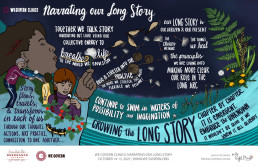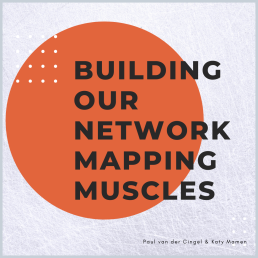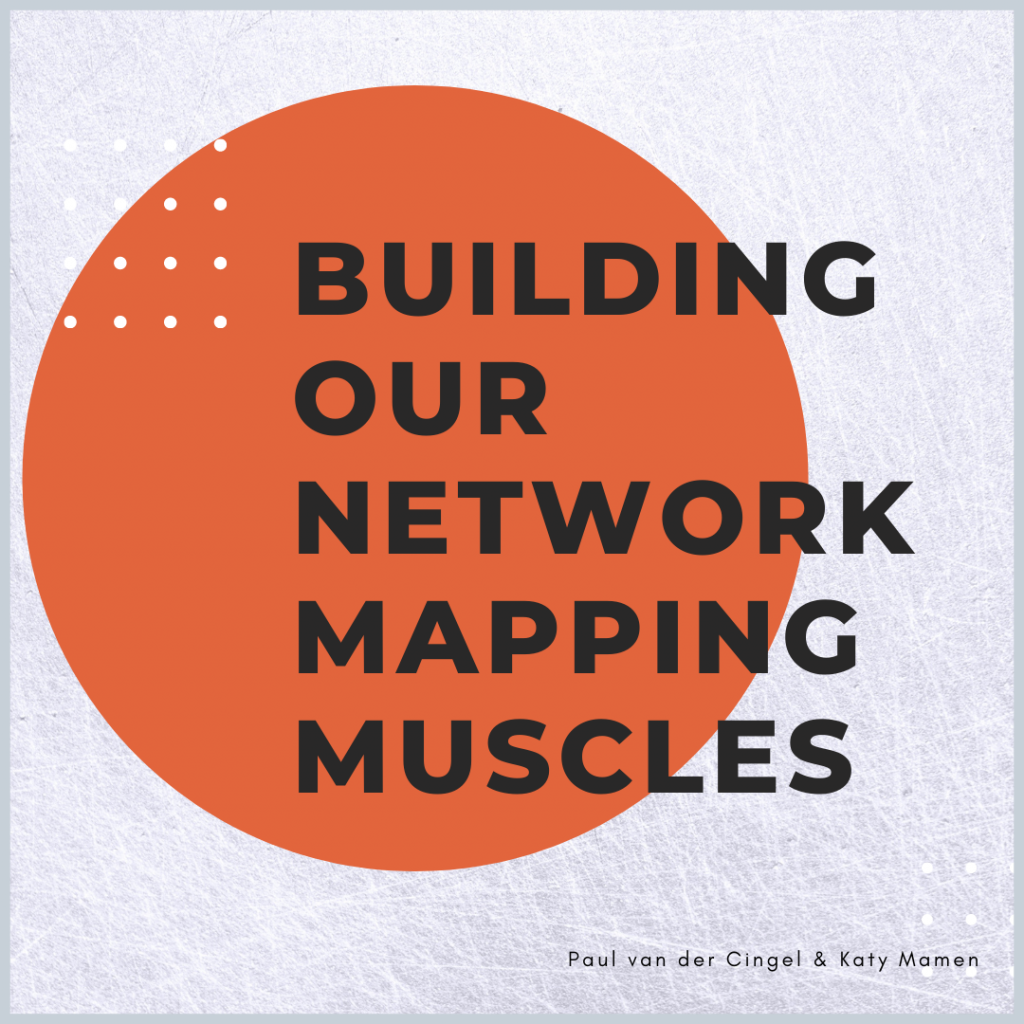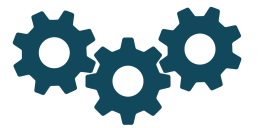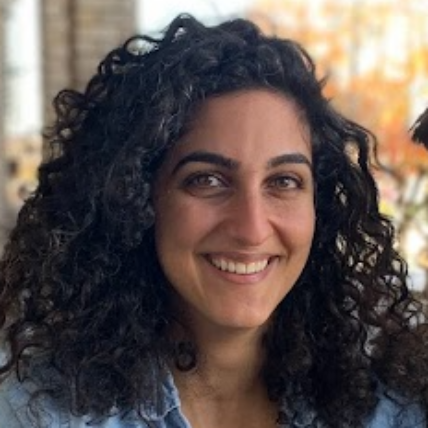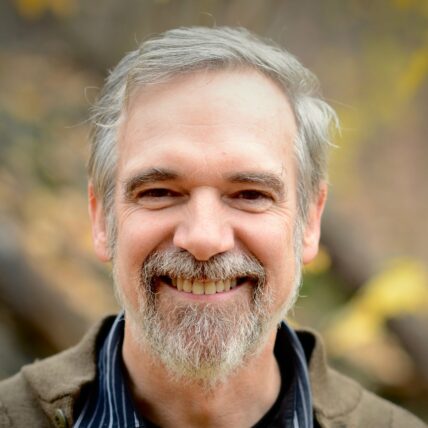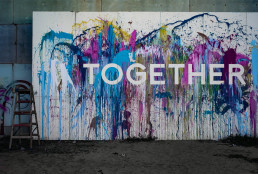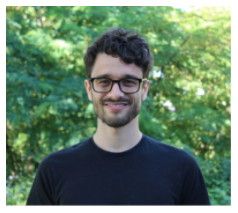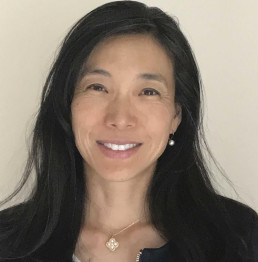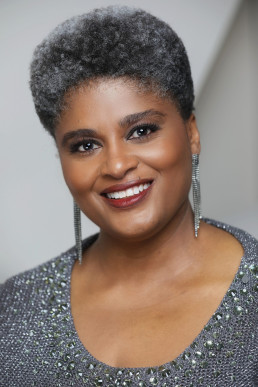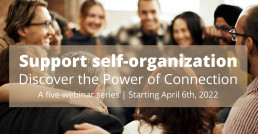Governance is how we choose to be together
April 26, 2022Network Structure and Governance,Transformation,BlogTransformation,Governance,Liberatory
An illustrated story of liberatory governance practice
Storytelling — like governance — can take many forms.
When choosing new ways of being together, we begin with ourselves — in our bodies, hearts, spirits. The choice to be in governance rooted in mutual care is an embodied one. Once it rests within us, the practice begins.
Accordingly, the story of governance practice is a multi-sensory one. It takes shape in the colors, textures, voices, sounds, and sensations of our beloved communities — it is multi-dimensional.
Last year, a group of worldbuilders came together with a shared commitment to collective liberation — and the governance principles we’ll need to bring it into being. Together, we moved through a series of clinics to deepen our collective governance practice.
What follows is a constellation of words, images, and musical offerings to describe this journey into liberatory governance. These images are the work of our beloved Adriana Contreras Correal of On the Right Mind. Deep gratitude to Adriana for sharing her gifts with us.
We invite you to enjoy our practice playlist and delve into the story below…

Collective governance begins with a choice: to commit to the ways of being that enable all beings to thrive:

Transformation begins when it’s personal: once we’ve committed to collective governance, we begin by grounding in place. Our work begins at home:

As our practice takes root, we continue illuminating the path toward what is possible, by narrating our visions for our communities into story:

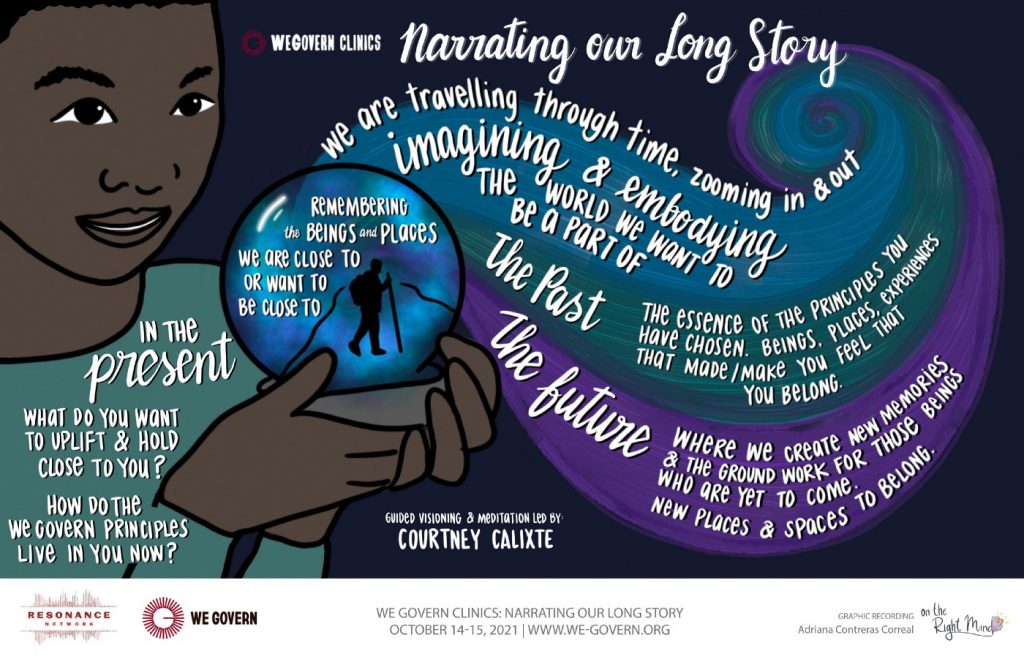
Holding close to our stories of liberatory futures, we focus in on policies and actions we will need to sustain a world beyond violence — a world where all beings can thrive:
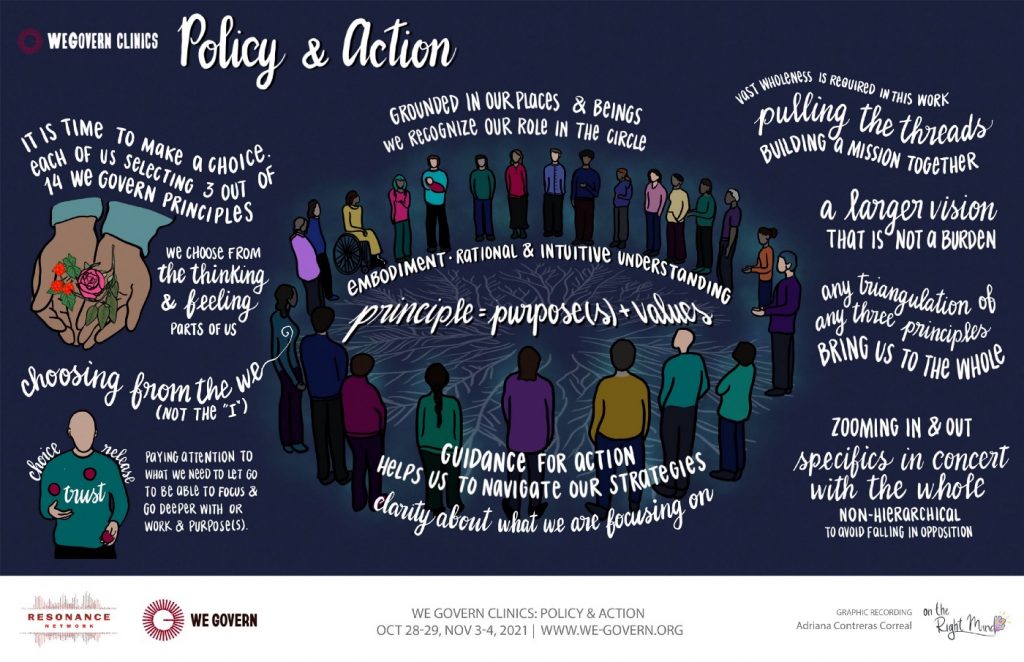

Originally published at Reverb
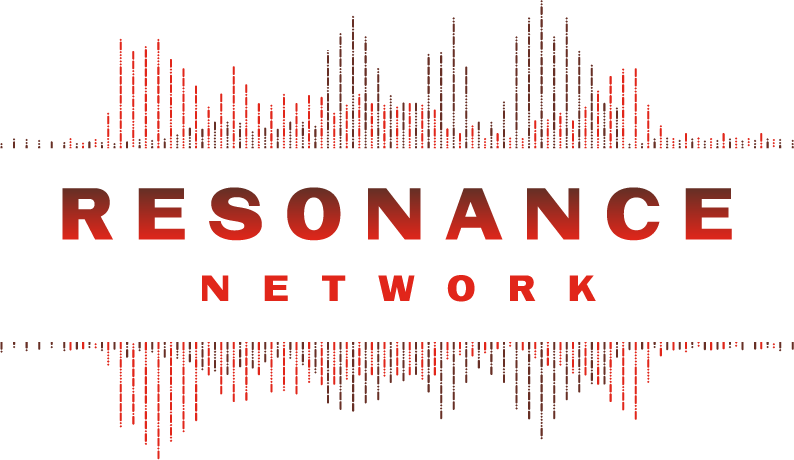
Resonance Network is a national network of people building a world beyond violence.

Network Weaver is dedicated to offering free content to all – in support of equity, justice and transformation for all.
We appreciate your support!
donate in the box above or click here
MAKING LARGE EVENTS PARTICIPATORY
April 19, 2022Network Processes,TransformationBlog,Systems Change,Collaboration
This blog was originally published in October, 2019, when we couldn’t foresee that most large events would cease. As we anticipate meeting again in person, I hope the approaches here give you ideas. You might like to check out my new meeting design coaching services.
It’s possible to make large events participatory and interactive. Here we share our latest inspiration and approaches, from recent work with events from 50 people to over 200 people. The topics and audiences vary, yet the desire to inspire and connect people, enhance learning, build connections, and advance work beyond the meeting is the same. Here’s what goes into our secret sauce for creating a participatory, inspiring event:
Participation starts in design: Working with a design team that includes representatives of the people who will be participating in the event helps ensure the event format is relevant and effective. This group can:
- Bring varied perspectives to clarify the context and conversations that are needed now. For example, with a state-wide food network that’s been underway for five years, we landed on this strategic question: How can the structure and approaches of the network galvanize and support action and momentum at the local, regional, and state levels? It took some thinking and conversation to get clear that this was the most powerful question for this moment. We brought in case studies to spark the conversations.
- Provide input on the format of the meeting and who to invite and how, e.g., you can access the broader social and professional networks of those in the room to learn about other people, organizations, and initiatives who could be invited.
- Serve as ambassadors for the vision and the meeting/initiative, spreading the word, helping with invitations, and sharing feedback they are hearing.
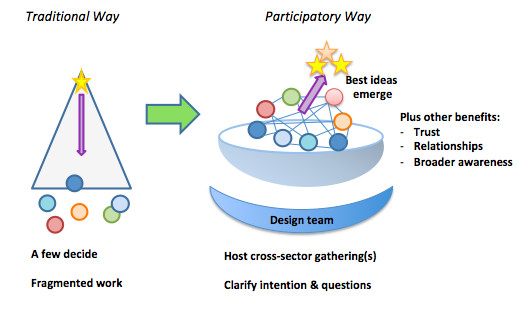
For example, we co-facilitated the annual meeting of the Greater Nashua Public Health Network, with a focus on building a trauma-informed community. The design team helped us get a sense of how much training had been done so we could tailor the content of the training portions. We agreed on a clear set of desired outcomes and went through several rounds of an agenda design, tailoring and improving it each time, based on their feedback.
At the event, start with stories: Getting people sharing stories early in the day builds relationships and creates a warm, welcoming environment. Our approach is inspired by an exercise called Radical Acceptance, which I learned from taking improv classes with Boynton Improv Education in Portsmouth, NH. This simple exercise builds a sense of emotional safety and encouragement for everyone to speak up. I modified it slightly by doing the following:
- At round tables, invite each person to introduce themselves and share one brief story of something going well in their work. Invite everyone to respond with a “yes!” or any other enthusiastic positive response. Then the next person goes and the group does the same. Across the room you hear “yes!” and clapping and laughter, and see fist bumps.
- In another variation at the Nashua meeting, we asked each person to share one thing they appreciate about Nashua/the region and put it on a post it note. We used the same process I mentioned and then collected these and had a graphic facilitator make a poster of the themes.
This only takes 10-15 minutes. Sometimes people pick up on the “yes!” and bring that positive response into other parts of the day, often with a shared laugh.
Offer inspiration/new ideas and new voices: Beyond the standard keynote presentations and skill-building workshops, consider having shorter TED-talk type or PechaKucha presentations (presenter has about 7 minutes to talk with 20 image slides) and featuring voices beyond “experts,” e.g., youth, those with lived experience, people from marginalized identities or communities.
Host cross-pollinating small group conversations: The World Café process taps the ideas of everyone in the room and allows people to make new connections and learn from each other. At an anti-racism gathering of 200+ people from Maine, New Hampshire, and Vermont, we invited people to talk in a group of four with people from their state about what is working in anti-racism work. In the second round, they mixed to a new group of four with people from other states, sharing themes from the previous conversation, and then talking about what more was needed. With 200 people, this meant we had 50 four-person conversations each round (100 total), which is a lot of learning and information exchange…and fertile ground for new relationships and collaborations to form.
Allow space for self-organized deeper dive conversations: All of the conversations and ideas percolating through the first part of an event can be given a space to land and deepen if you design space for that. Inspired by the process of Open Space, here’s an example of how we organized this at the event with 200 people:
- During the morning sessions, we asked people to submit topics they’d like to discuss with others at an Open Space/deeper dive conversation session that afternoon.
- Over lunch, we grouped these into about 16 overall topics. I made folded table tents with a table number and name of the topic and put these out on the round tables. I sketched a chart showing table numbers and topics, took a photo, and put it up on a slide.
- When that session began, I invited people to join the topic they’d like to discuss and walked around with a roving microphone to introduce the topics and show which table was where, with the slide image as another guide.
- We asked for a note-taker at each table. For topics where lots of people showed up, we invited them to split into several tables. At the end, we heard brief highlights from the table conversations.
At another event, we had time for people to rotate to a second topic table, while some people stayed at the first one, building in another layer of connection and cross-pollinating.
The range of topics that were suggested were far beyond what our design team would have thought of, and we learned which areas had the most interest. People had the freedom to initiate or join conversations and connect with others with similar ideas, concerns, and questions.
I wish I could somehow visualize and learn all the seeds that got planted at these events. We offered the fertile ground – so time will tell what grows!
Beth Tener is a leadership trainer and coach who helps social change leaders live their values as they address complex challenges, such as transitioning to a clean energy economy, disrupting racism, and revitalizing communities. She is passionate about bringing people together in ways that unlock and ignite personal, group, and community potential. She is the founder of New Directions Collaborative, based in Portsmouth, NH, and has worked with over 200 organizations and collaborative networks.
originally published at New Directive Collaborative
featured image found here
Building Our Network Mapping Muscles
April 12, 2022Network mapping,Uncategorized
On Wednesday March 16th Katy Mamen and Paul van der Cingel held a webinar on “Building Our Network Mapping Muscles.” For those of you who weren’t able to attend the session, we are making the video available as part of the resource packet on network mapping. This resource packet also includes a more detailed slide deck than the one shown in the video.
Many other mapping resources were mentioned in the chat.
- Many people use kumu.io to visualize their mapping data. There are tutorials on their site and Christine Capra (Greater than the sum) can help.
- NodeXL has a focus on using twitter and Facebook data as a way to surface relationships in larger groups.
- SumApp is the survey platform that many people use to gather mapping data from network participants. See https://greaterthanthesum.com/
- There is a community of practice for network mappers. You can sign up here
- June Holley shared a set of sample questions you can use in a survey Christine Capra added, “A pair of questions that's been really useful in some networks I've worked with are 'what are the opportunities you're seeing?' and 'what challenges are you facing?'”
- There are 6 additional mapping resources here.
You can contact presenters at katy at sonic.net, p.van.der.cingel at windesheim.nl and christine.capra at gmail.com
Download the full resource - including the slide deck and PDF with link to webinar, HERE. OR Access the webinar directly, HERE.
Adapting a network’s theory of change
April 11, 2022Transformation,BlogSystems,Transformation,Systems Change
Collective Mind hosts regular Community Conversations with our global learning community. These sessions create space for network professionals to connect, share experiences, and cultivate solutions to common problems experienced by networks.
On September 22nd, 2021 we met with Carri Munn from Context for Action and Amelia Pape from Converge for our first Community Conversation of the fall. Carri and Amelia shared their experiences collaborating with network teams to adapt Converge’s theory of change to their networks and the process and successes of co-creating a shared theory of change with network leaders.

Highlights from the conversation
Complex problems are by nature nonlinear and typically must be addressed from many angles at once. This is why networks, in their ability to connect and facilitate collective action between people and organizations, can be successful and impactful in creating system change in complex environments. As defined by our co-hosts, a theory of change describes how a network can create systemic change by harnessing the interdependence of the network system – its members.
The way networks create system change – or their theory of change — can often emerge in phases. The conversation outlined these phases, beginning with connecting the actors within the network system, working towards building trusting relationships and an understanding of members’ contexts. This is the foundation necessary to reach the coordination phase, when regular communication and coordination starts to occur between people within the network, people are supporting the work and each other, silos are starting to break down, and information, value, and learnings begin to flow from the connections that have been created. From here, the collaboration phase emerges and members begin to recognize a shared purpose within the larger system and opportunities to collaborate within it. It is these emergent collaborations that begin to create and perpetuate more and new collaborations and, eventually, system change and impact at scale.
This phased framework is a way to talk broadly about a network’s theory of change. However, network leaders often need a specific and contextual theory of change to effectively communicate to and strengthen the network. Our co-hosts shared an example of using this framework to support a network interested in transforming a broad theory of change to one that represented their network’s specific activities, as a means to communicate and collaborate more effectively with its members and stakeholders.
Using the phased theory of change framework — connection, coordination, and collaboration — our co-hosts described their process, which started with using surveys and conversations to gather information from the network about the challenges, barriers, and opportunities that existed within the network system in its current state, and to describe the optimal system impact, or the realized vision, they hoped to achieve. These became inputs for a virtual Mural storyboard session where they facilitated a smaller group of network participants to articulate what they hoped to create and achieve in each phase and how they viewed their roles and relationships within these phases. The storyboarding exercise was a way to help the network articulate how they would create the conditions for impact and collaboration to emerge that would be considered those of a healthy network and then use those outcomes as a tool to communicate with and bond the network.
What also emerged from this conversation was the critical role of network coordinators in theory of change processes. Coordinators are often the catalyst in orienting networks to see the bigger picture. As facilitators of a complex system, it often falls to them both, by necessity and design, to engage members in conversations about how they see themselves as part of a larger whole and how to contribute to transformational change in the network system.
Miss the session? View the recording here.
Sign up for the Collective Mind newsletter to receive these in your inbox!
Thanks again to our co-hosts, Carri Munn and Amelia Pape!
Get involved
Have your own experiences developing a theory of change? Tell us about it in the comments below.
Join us for the next Community Conversation!
Or email Seema at seema@collectivemindglobal.org to co-host an upcoming session with us.
original article published HERE
Announcing Kinship: a new initiative
Hello to my network weaver peers! Over the last 10 years, I’ve been exploring how to use networked approaches to align the work of many organizations to change systems. Through New Directions Collaborative, Nancy Gabriel and I and some colleagues in this network have worked with initiatives working on food systems, community development, climate action, and more. We learned a lot about how to create successful collaboration, especially refining how to facilitate work with a focus on outcomes, equity, and on building trusting relationships every step of the way. I hope you will find these blogs sharing our experiences and this Resource page useful.
I’m now focused on creating a new initiative called Kinship: A Hub for Amplifying the Power of Community to practice and deepen our skills in how to create a community that can heal, collaborate, learn, and care for the whole.
Remember to imagine and craft the worlds you cannot live without,
just as you dismantle the ones you cannot live within. – Ruha Benjamin
In the spirit of looking for what is missing and growing what is healthy, my vision is to host regular spaces in my community of Seacoast New Hampshire where experienced community builders and social change leaders can connect with peers, get coaching, and learn together. I’m curious to see how hosting and weaving a place-based community over time can root and grow a culture of solidarity, healing, and co-creation. My hope is that people take what they experience in Kinship spaces back into their homes, workplaces, and communities.
As our families and communities face unprecedented changes, we need to move from go-it-alone individualism to create resource-rich environments of care, peer support, and resonance. I see a need for ongoing community-connecting spaces to fortify us so we can respond to change with creativity, care, and courage. Deep bonds of kinship with each other and nature is also a resource for burnout, mental health challenges, and healing trauma and oppression.
Please check out the new Kinship web site and if you'd like to join our newsletter, enter your name at the bottom of the home page or like this Facebook page. I will host small groups and facilitate workshops in person in Seacoast NH and will be producing a podcast (stay tuned.) I’m offering on-line trainings as well, including these in April:
Listening that Enables New Possibilities
Storytelling that Grows Connection and Learning.
I’ll be keeping New Directions Collaborative as my business entity. Nancy and I have revised the service offerings to focus on training, meeting design and serving as thinking partner/coaches. We will be shifting out of on-site facilitation and cross-sector systems change work and will look to give referrals other consultants who do this work.
I look forward to sharing back with this community how Kinship evolves and what we create and learn. Perhaps down the road, what grows here can generate seeds that we can share with others to bring into their communities.
Experimenting Towards Liberated Governance
April 5, 2022Network Structure and Governance,Transformation,Blog,Network Leadership,SystemsLiberating Structues,equity,Systems Change
Over a year ago, Vu Le published an article about the current models for nonprofit boards. The title “The default nonprofit board model is archaic and toxic; let’s try some new models” doesn’t bury the lede. Of the current models, Le writes:
“Over the years, we have developed a learned helplessness, thinking that this model is the only one we have. So we put up with it, grumbling to our colleagues and working to mitigate our challenges, for instance figuring out ways to bring good board members on to neutralize bad ones or having more trainings or meetings to increase ‘board engagement.’”
At Change Elemental, we have been experimenting with some new governance models, informed by the work of our clients, partners, and many others in the field who are trying out new structures and ways of governing. For example, Vanessa LeBourdais at DreamRider Productions has shared principles and practices of “evolutionary governance”, and Tracy Kunkler at Circle Forward has supported our learning about consent-based decision making. Countless other groups who have continued to uphold and practice historic, ancestral, Indigenous, and intergenerational structures of governance—and have informed these other values-aligned governance models—have catalyzed our learning.
Here, we offer a specific window on the evolution of our board, including some practices we’ve dreamed up, borrowed, and re-remembered to align governance with our values in a nonprofit system set up to default to white supremacy, paternalism, power over, and other oppressive habits.
The following questions have formed the basis of our governance and leadership evolution (we’ve shared more about our leadership evolution in recent blog posts here and here):
- How might we realize deep equity and liberation in leadership and governance?
- How might we evolve leadership and governance structures to share power and work in more networked ways?
- How might we align leadership and governance practices and culture with our values?
Our journey began a few years ago when our board and core staff team began to get curious about what it might look like to think about our board as mycelium. Mycelium are fungal networks that spread across great distances within soil (and sometimes underwater) and process nutrients from the environment to catalyze plant growth, supporting ecosystems to thrive. In our context, we use mycelium to refer to the powerful network of tendrils and roots that connect our board and core team to other people, groups, and organizations, enabling us to turn toxins into nutrients and nourish ourselves through our relationships to ensure collective thriving and care.
Here is what we’ve learned so far in our governance evolution (from the core team perspective—more from our governance team coming soon!):
Shifting language from “board” to “governance team” helped us reframe the governance team’s role.
Early on we shifted from referring to our board as “a board of directors” to a “governance team.” Tracy Kunkler of Circle Forward offered this definition in a small group experiment on governance we facilitated:
“Every culture (in a family, a business, etc.) produces governance — the processes of interaction and decision-making and the systems by which decisions are implemented. Governance is how we set up systems to live our values, and leads to the creation, reinforcement, or reproduction of social norms and institutions. Governance systems give form to the culture’s power relationships. It becomes the rules for who makes the rules and how.”
Shifting language supported us to shift our mindsets about governance. This language guided us towards greater clarity about our own governance team’s role: co-creating systems and practices that can support and catalyze us to live our values. It also deeply shifted how we both hold and reimagine the boundaries between the 12 people on our governance team, our core team (staff), and other partners to be more porous and center collaboration, emergence, and our interconnectedness.
However, because shifting mindsets requires shifting patterns and practice, this switch in language isn’t simple. We have noticed that we sometimes revert to using the term “board” rather than “governance team” when we are talking about potential barriers that the board may present or “traditional” board responsibilities such as fiduciary oversight. This is a work in progress and when we find ourselves reverting to old language, it is a signal that we might be in older practices, patterns, or ways of thinking about our relationship to the governance team and its role that are no longer serving us or our work.
Practicing liberatory governance is having one foot on land and one in the sea.
Getting clearer on our governance team’s role deepened our sense of what it might look like to realize deep equity and liberation in governance. We began to understand what “liberatory governance” could look like for us—a governance team that partners with us to bridge between current reality and the future we’re building by: moving the organization towards greater alignment with our values; and co-creating liberatory systems and ways of working together that can transform the larger oppressive systems we’re operating within. We talk about this internally as “having one foot on land and one on water,” a metaphor Hub member Elissa Sloan Perry shared from Alexis Pauline Gumbs. Gumbs hears best with “one foot in the water, one foot in the sand.”
In our organizational context, the “water foot” attends to things like our vision, uninhibited aspirations, values alignment, and acting today in ways that prefigure the world we want to see. The “foot on land” takes into account the world as it is, such as the requirements and legal constraints of our 501.c.3 tax designation, and current financial realities and access to other resources, where trust-based relationships can sometimes become transactional or even litigious. Our governance model values both “feet” in its awareness and decision-making. When we make decisions, the “water foot” leads with the “land foot” as a valued, supporting, and crucial partner.
Creating multiple, fluid points of connection across the staff and governance team helps build the relationships and trust necessary for shared leadership and power.
Building trust and mutual accountability are at the heart of our evolving governance structures and practices, just as we have found it to be in building toward shared power and leadership at the staff level. This work is more time-consuming than conventional governance models so we needed to build our collective capacity for sensing what is actually too much time. We also needed to strengthen our skill and capacity for generative conflict including discerning when to: enter into conflict and tension; sit with it so that we can reflect and discuss later; and/or intentionally let it go. This has meant getting more comfortable with sitting in discomfort when conflict can’t (or shouldn’t) be resolved immediately.
Some simple structures and systems support us in developing these capacities and discerning what is needed to build trust and move through conflict. For example, we wanted more interaction between our core team (staff) and the governance team, but didn’t want to necessarily add more large group meetings—we wanted connections to be deep and purposeful. To create purposeful connections, where a broad range of staff and governance team members could develop relationships and bring their unique gifts, we opted to have governance team co-chairs work with a staff liaison. The staff liaison partners with different staff, bringing different people into conversations with the co-chairs and other governance team members where their experience, wisdom, and gifts are critical. The co-chairs and other governance team members then connect together and separately into different areas of work based on their interests, skills, and what is needed.
We also evolved our governance team meeting structure to have staff members join for key sections of the meeting. We share the agenda in advance and offer some guidance to help staff decide when they might join or when they might opt out of a meeting. Additionally, staff and governance team members now caucus separately at the end of each governance team meeting to debrief and raise unresolved issues with the intention of sharing back what needs the full group’s attention. The caucuses support greater truth-telling across the governance team and core team, deepen our understanding of each other’s perspectives and help us dig into conflict with love and rigor.
Grounding in shared values is critical for practicing liberatory governance.
If you were to review the specifics of our governance team’s role, you might not find anything surprising or “new.” The difference is in how the governance team carries out these responsibilities – with a rooting in shared values with staff and commitment to working through differences in values when they show up.
In recruiting and engaging governance team members, we haven’t just sought out individuals who conceptually agree with our values (which were reflected in our recruitment criteria), but people who are game to experiment on what it looks like to make decisions rooted in those values. People who already embrace and practice inner work, multiple ways of knowing, experimentation, and emergent strategy—and who are looking to upend traditional governance team models and create and remember anew.
Even with the perfect container, structure, and systems, it’s the people who make up our core team (our staff) and governance team – their own values as well as their willingness to be in the generative tension that helps support shared values – who have accelerated our work in shared power and leadership both on the core and governance teams. Together, we are living into our vision and deepening our practices of shared leadership and shared power to shift conditions towards love, dignity, and justice.
Look out for more learning from these experiments in liberatory governance in the new year!
Natalie Bamdad (she/her/hers), joined Change Elemental in 2017. She is a queer and first-gen Arab-Iranian Jew, whose people are from Basra and Tehran. She is a DC-based facilitator and rabble-rouser working to strengthen leadership, organizations, and movement networks working towards racial equity and liberation of people and planet.
Mark Leach (he/him/his) has over thirty years of experience as a researcher and management consultant. Mark has a particular interest in strategy, leadership development and transition, and issues of equity and inclusion in organizations.
Originally published at Change Elemental
Banner Photo Credit: Kirill Ignatyev | Flickr
The Art of Measuring Change
March 28, 2022Systems Change,Self Organizing,networks,Self-OrganizingReflection and Learning,Transformation,Blog,Systems
What are your associations with words such as “measurement”, “evaluation” or “indicator”? For many people these words sound annoying at best, and there are good reasons for it. Yet - given the fact that you clicked on this article - it’s also very likely that you are motivated to contribute to social change, and the main intention of this article is to share about the beauty and collaborative power of attempting to measure it. What I am not doing is offering quick solutions, the same way art is not a solution to a problem. Rather, it is an invitation to step back, look at the nuanced process of change with curiosity and an inquisitive mind, and maybe discover something new. The article is also available as a dynamical systems map.
In a nutshell
There are two ways of reading this article:
- Exploration mode: Use the systems map provided above and use the visual representation to navigate through the article more flexibly.
- Focussed mode: Stay here and follow the flow of the article.
Here already a quick overview of the main points and arguments:
- There is a good reason to be skeptical of impact measurement. If the approach taken is too simplistic and/or mainly serves to validate a perspective (e.g. of the donor), it’s almost impossible to measure what truly matters. Rather, such an approach further perpetuates existing power imbalances and puts beneficiaries at risk. (section: The dangers of linearity)
- The measurement of social phenomena has to pay justice to the intricacies and complexities of a project, a program, or any given action. This requires understanding, which puts empathy, listening and collaboration at the centre of an empowering approach to measuring change. (section: About potluck dinners and “power with”)
- Meaningful indicators serve as building blocks in the attempt to capture social change. An indicator is meaningful when it not only follows the SMART principles, but is also systemic and relevant, shared (understood and supported by all stakeholders) and inclusive (aware of power relationships). (section: Indicators that matter)
- Complexity science can provide an alternative scientific paradigm to understand and make sense of our world and, hence, to measure change. (section: Coming back to complexity)
- It’s time to equally distribute power, namely the ability to influence and shape “the rules of the game”, or potentially even the kind of game that is being played in the first place. A crucial step towards this is describing and defining what desired social change is and how we go about measuring it in a collaborative way. (section: Synthesis)
The starting point
I have been working in the field of impact evaluation and measuring social change for around 6 years now. I’ve interviewed cocoa farmers in Ghana, developed surveys and frameworks, crunched Excel tables of different sizes and qualities, mapped indicators, and held workshops on tracking change in networks. Doing all of this is way more than a job to me. I have met wonderful people on this path, have been part of impactful projects and really had the feeling of being able to contribute in a meaningful way.
To me, impact evaluation is an ambitious, creative and collaborative application of complexity science (more on that later). It can be a deeply empowering process that reveals hidden opportunities and structural challenges, creating empathy between groups of people.
And it can be harmful.
The dangers of linearity
Let me share a definition with you to explain what I mean:
“An impact evaluation analyses the (positive or negative, intended or unintended) impact of a project, programme, or policy on the target population, and quantifies how large that impact is.”*
I agree with that definition in general, yet when it comes to the details in language, my opinion differs significantly. For example:
- Nobody is or should be a target. We don’t shoot projects, programs or policies at people, we work with people.
- Quantification plays a role, but we should also qualify impact.
- It is not said who has the power to define “positive or negative”, and “intended or unintended”.
These are not simply trivial semantic differences. All too often I experienced situations where impact evaluation was used by organisations to prove and validate the effectiveness of their services, rather than to truly understand the perception and consequences of what they offer.
Here is an example of what I mean: A couple of years back I had the opportunity to visit cocoa farmers in Ghana for an impact evaluation for an NGO. We found out that, yes, the NGO’s activities are actually having an effect and are contributing positively to farmers’ income. But we did not capture in writing the fact that most farmers stopped growing subsistence crops for their own consumption, hence making themselves more vulnerable to global trends and market prices. A few months after I left, the market price for cocoa dropped significantly. We did not capture it as it was not part of our evaluation framework or our mental model about what counts as relevant information.*
This is what happens all too frequently: We have pre-defined and pre-conceived notions of what counts as a data point, and what doesn’t. This again is usually based on a linear model of thinking (aka “A” leads to “B”), not accounting for the complexities and intricacies of human interaction and social systems. I have talked to so many people in the field that were frustrated, stating something along the lines of “we don’t measure what is truly relevant”.
To put it another way: If empathy and understanding are not at the centre of impact evaluation, both as the foundation and the goal, then it might be (unintentionally!) used against the people we want to benefit. It’s like having a knife in your hand. You can use it to prepare a delicious meal, but also to hurt yourself and others.
About potluck dinners and “power with”
Let’s dig a bit deeper into that: We’ve learned that what we do in impact evaluation is to assess the change attributed to an intervention (a project, program, workshop etc.). You do something and then something else happens. Now, we want to understand the “somethings” and how they are connected. This is not as simple a task as it may seem. Reasons include:
- We humans love to make our own meaning. You (and your organisation) probably know what the intervention is, but others perceive it fromtheir own perspective and life reality.
- Change is like air: Ever-present and hard to grasp. The “mechanics” of change can’t be pinned down easily and require us to look at context & conditions. Similarly, we know how difficult predictions are. Should we trust the weather forecast? For the next 3 to 5 days probably, but beyond that?
- There is power in the game: Oftentimes, multiple stakeholders and their multiple opinions are involved in an evaluation. There is nothing wrong with that per se, yet it is important to acknowledge.
The art of impact evaluation, therefore, is not to publish fancy reports, but to apply it in such a way that it deepens the internal understanding of issues at hand and strengthens the collaboration between actors. When this is the case, It builds empathy and human connection, and enables stakeholders to jointly develop shared meaning and scenarios for social change and transformation.
In other words, impact evaluation is based on and deepens listening. Listening not only to people, but to their context and to groups of people, to underlying and invisible challenges and hopes.*
In a more recent project I worked on we called all stakeholders together from the very beginning. It was clear who “has the money”, but we also shared the ambition to collaborate on a level playing field. As a consequence, we co-developed the project’s vision and the evaluation framework. We made clear that the first round of data collection also serves the purpose to understand what is relevant; and that the project goals will be further developed based on the “reality on the ground” rather than the content of the funders’ strategy paper.
We created the space for a genuine dialogue, and the data collected further strengthened the mutual understanding and trust in the group and in the process. It revealed both further challenges and where the leverage points are for creating systemic impact. It also became clear that power is not only linked to money.
“What makes power dangerous is how it’s used. Power over is driven by fear. Daring and transformative leaders share power with, empower people to, and inspire people to develop power within.” (Brené Brown)*
What we did was to ask a different question than normal. The central question was not “how can one central stakeholder prove their impact?”, but rather “how can we jointly contribute to desired change for a matter that we all care about?”. Shifting the question means that stakeholders and their individual contributions are valued differently, and that the quality of interaction changes.
Speaking in the metaphor of our delicious meal: We did not go into a restaurant where you tell somebody what should be cooked for you. Rather, we sent out the invitation to join a potluck dinner. Organising a dinner in this way does not happen at random. It requires clarity on roles and contributions, as well as shared agreements (e.g. on when and where to meet). The fundamental difference to a restaurant visit, though, is that it values participation and what each stakeholder (dinner guest) brings to the table, which in turn requires a mindset of being curious and open to surprises.
So far so good, but how do we actually measure change?
Jannik Kaiser is co-founder of Unity Effect, where he is leading the area of Systemic Impact. His desire to co-create systemic social change led him down the rabbit holes of complexity science, human sense-making (e.g. phenomenology), asking big questions (just ask “why” often enough…) and personal healing. Having worked in the NGO sector, academia and now social entrepreneurship
Originally published at Unity Effect
featured photo by Adi Goldstein on Unsplash
Jane Wei-Skillern
Jane Wei-Skillern is a Senior Fellow at the Center for Social Sector Leadership at the Haas School of Business at University of California, Berkeley. Previously, she has served on the faculty at the Stanford Graduate School of Business, Harvard Business School (HBS), and London Business School. She has studied and published extensively on nonprofit networks for more than two decades. She is the author and coauthor of dozens of HBS and Haas UC Berkeley case studies, book chapters, and journal articles and is the lead author of the casebook, Entrepreneurship in the Social Sector (Sage Publications, 2007).
Dr. Froswa' Booker-Drew
Froswa’ Booker-Drew, Ph.D. is a Network Weaver who believes relationships are the key to our personal, professional, and organizational growth. She has been quoted/featured in Forbes, Ozy, Bustle, Huffington Post, Modern Luxury, and other media outlets, due to an extensive background in leadership, nonprofit management, philanthropy, partnership development, training, and education. She is the CEO of Soulstice Consultancy, LLC providing DEI, leadership training, community engagement strategies and philanthropic/partnership guidance for institutions and the CEO of R2 Foundation (Restoration and Reconciliation Foundation) providing support for Black led nonprofits. Formerly the Vice President of Community Affairs for the State Fair of Texas, Froswa’ was responsible for grantmaking, educational programming and community initiatives. More than 70% of organizations funded were led by people of color. As the previous National Community Engagement Director for World Vision, she served as a catalyst, partnership broker, and builder of the capacity of local partners in multiple locations across the US to improve and sustain the well-being of children and their families. She is also co-founder of HERitage Giving Circle, one of the first Black women Giving Circles in the state of Texas and co-founder of both Power in Action-Dallas and the South Dallas Employment Project.
Bridge the Gap between Vision and Reality: a webinar offering
It’s a joy when self-organization works well. It’s a drag when it doesn’t. The gap between how it can be - or should be - and what it is can sometimes be too big. That’s especially true when individual team members lack flexibility and self-reflection, when decision making by the team is driven by hidden power games and not-so-hidden rigid and defensive behaviour, and when there is a lack of openness. These create frustration, distance, demotivation, powerlessness, and other symptoms indicating that collaboration is not as effective and joyful as it can be. It reduces the quality of work.
Experts show you a piece of the puzzle of what self-organization can be like. Most of them offer an inspiring glimpse of what is possible. But when the gap between their vision and your day-to-day reality is too big, you might get frustrated. You may even doubt your capability to make self-organization work well within your team or organization. Vision without a direction is like hearing someone speak about Paradise, without showing you how to get there and providing tools to accelerate your journey. So, how do you get there?
- Declaration of Responsibility
The first step you all take is to sign the declaration of responsibility. You declare that you are willing to take full responsibility for yourself, the team (the collaboration), and the quality of the service or product that your organization provides. You never relinquish that responsibility.
- Responsibility for yourself
To take full responsibility for yourself, you need self-awareness. You need to know who you are and what drives you, the purpose in your life, and you need a healthy mind-body balance to convert the signals your senses give you into actions that allow you to take good care of yourself and others.
- Responsibility for your team (collaboration)
To take full responsibility for your team, you need insight into the invisible forces that influence everything you do. Compare it to the operating system of your computer or tablet. If that doesn't work, no software will work well, and you won't achieve the desired outcome. The Periodic Table of Radical Respinsibility is a learning tool to help you build a solid operating system.
- Responsibility for the output
To take full responsibility for the quality of what you as a team deliver, you need an instrument to 'measure' the level of trust in your team or organization. After all, trust determines what you can achieve. A profound tool for measuring the state of trust in four dimensions is the Power of Connection model (image). You can use it both as a reflection and feedback tool.
For over 30 years, Norbert Netten, founder of The Power of Connection method, has worked with teams to provide insights and tools they need to strengthen their collaboration. Norbert is a strong advocate for self-organization. When it works well, it supports people to take responsibility for themselves, the team, and the quality of their work, without compromising on any of those factors, which is what usually happens.
Webinar series
Norbert Netten, founder of the Power of Connection, is organizing a webinar series on how to bridge the gap between vision and reality. In five webinars, starting April 6th, you will explore the Declaration of Responsibility and Transactional Analysis. You will also learn to use the Periodic Table of Radical Responsibility learning tool and the Power of Connection model reflection tool to bridge the gap between vision and reality. This is a great opportunity to reflect on the quality of collaboration within your team or organization. And when you do recognize a gap, you can immediately start closing it and use your power to reach your goals.

Full details and subscription HERE
The code for 15% discount for Network Weaver subscribers: NWSS22-1 (Capitals!)
* This webinar announcement is published as an extension of Network Weaver's Community Space. We offer space for sharing on this platform, and invite you to use information shared here as it serves you.
